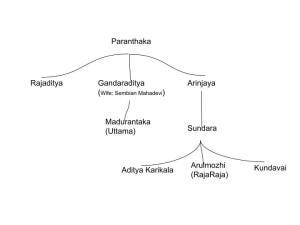Ponniyin Selvan: History behind the beginnings of the great Chola Empire.
As Mani Ratnam’s magnum opus Ponniyin Selvan(Child of the river Ponni) nears its theatrical release, there is a curiosity among the new generation, who want to know more about the bygone era and the past glory of great emperors.
The mighty Cholas were one of the four major kingdoms south of the river Palar in Southern India, the others being Pandiyas, Pallavas, and the Cheras. These kingdoms often had convenient alliances as well as constant confrontations with the kingdoms north of Palar. The Gangas, Rashtrakutas, and Chalukyas ruled southern Bharat stretching west to east from the Arabian Sea to the Bay of Bengal and from North to South from the Vindhya mountains to the Palar river.
This preview is about the Cholas. So who were the Cholas? There are many sources and books chronicling the life of the Cholas but I find K.A. Nilakanta Sastry’s work “The Colas” is the most detailed and unbiased.
This dynasty is closely associated with Tamil culture( and some Telugu culture in parts of today’s Cuddappah, Kurnool, and Anantapur as well towards the 12th century) tracing its origins to the Sangam age.
The Chola power was prominent in 4 ages, beginning with the late Sangam age(1000 BCE-1 CE) where the Sangam literature talks about many Cholas kings but there is no archaeological evidence for any of this. The second century CE featured one of the greatest emperors the world has known – Karikala Chola. After Karikala, nothing much is known about the Cholas till the 9th century. This is when the Chola glory is beginning to be revived with Vijayala Chola, whose family tree is what primarily makes up Kalki’s Ponniyin Selvan.
The landscape of the Cholas has historically been around the river Kaveri also called Ponni and its main branch Kollidam which deposits itself in the Bay of Bengal. The glory of Kaveri has unrelentingly been portrayed in Tamil poetry, with the mythology that the river originated from the waterpot of Sage Agastya himself. The dynasties of Bharath are typically classified as Solar(Surya) and Lunar (Chandra). Sage Agastya was responding to Chola King Kanta who underwent penance for the exaltation of the “Children of the sun”. The Cholas are thus the premier representatives of the Solar dynasty.
So where does Ponniyin Selvan start? Around 840-850 CE is when the fortunes of the Cholas turned, with the new King of Uraiyur, Vijayalaya. Uraiyur was a major city but the Cholas were subservient vassals to the Pandiyas and Pallavas at this time. Vijayalaya successfully played them against each other by aligning opportunistically, eventually capturing Tanjore on behalf of the Pallavas. The Pallava king Aparajitha, assigned the Uraiyur and Tanjore areas to Vijayalaya thus clearing the way for the tiger cub to become a tiger.
Vijayalaya’s son Aditya I further consolidated and followed the footsteps of his father with calculated raids and opportunistic alliances and slowly grew the empire.
All this culminates in the battle of ThiruPurambiyam which is noted by many as the turning point in the history of the Cholas and South Indian history in general. The Pandya king was defeated by the Pallavas led by Aparajitha, with support from Aditya I. However the Pallavas were weakened in the process and Aditya deftly played a political game with the Gangas and eventually conned Aparajitha, taking over the entire Thondai region( Modern Madras), the realm of the Pallavas.
By 907 CE, Paranthaka, son of Aditya I ascended the throne. He ruled for almost 50 years.
The Chola line from Paranthaka I
The story of Ponniyin Selvan encompasses the lives of Sundara Chola and his sons( and daughter Kundavai) and Madurantaka and his mother Sembian Mahadevi ( wife of Gandaraditya). The intrigue is fictionalized by adding characters that are not part of history like Nandini and Vallavarayan( there is a reference to this name however not as depicted in the story).
By the time Arulmozhi(RajaRaja Chola) ascended the throne, archaeological records talk about a difficult time period where the real characters are shrouded in mystery. There is evidence of Aditya defeating and killing ViraPandiya but it is not clear if he beheaded him as is said in the story.
Many records indicate that Aditya and Parthivendravarman were one and the same and it is plausible that after Sundara Chola, it was AdityaKarikala who because of this closeness with the Pallava land took on the name Parthivendran. Uttama was named king after Aditya died. The death of Aditya is however debatable and there is much controversy over whether he was killed and if so who killed him.
In Kalki’s story, Uttama is crowned king because Arulmozhi gives up his rights after his brother Aditya is murdered. However, there are records to indicate that Aditya became the emperor after Sundara and ruled for a few years, followed by Uttama.
What is not debatable is that ArlmozhiVaraman succeeded Uttama Chola around 985 CE and thus began one of the greatest empires the world has seen spanning large parts of modern India and Indonesia for over 250 years.
The age of Rajaraja Chola and Rajendra Chola had begun.




